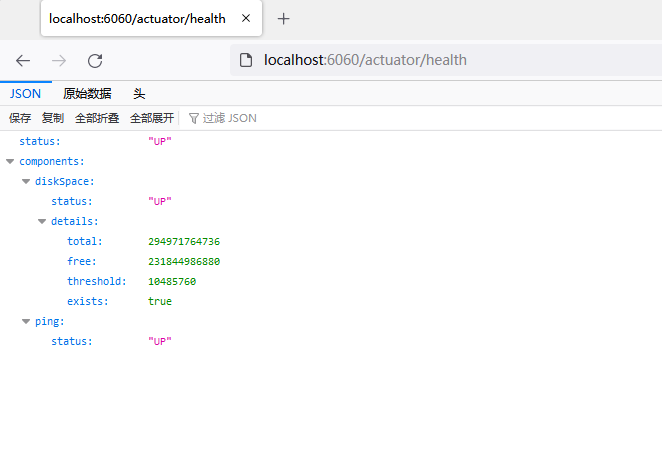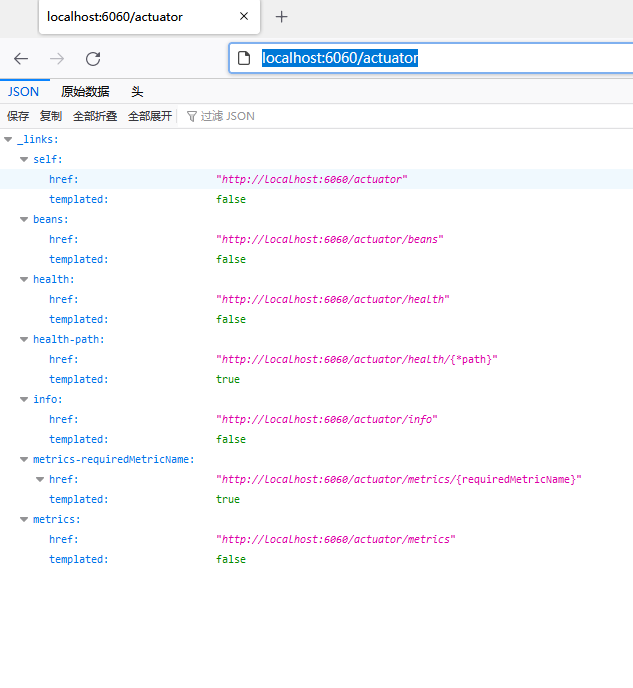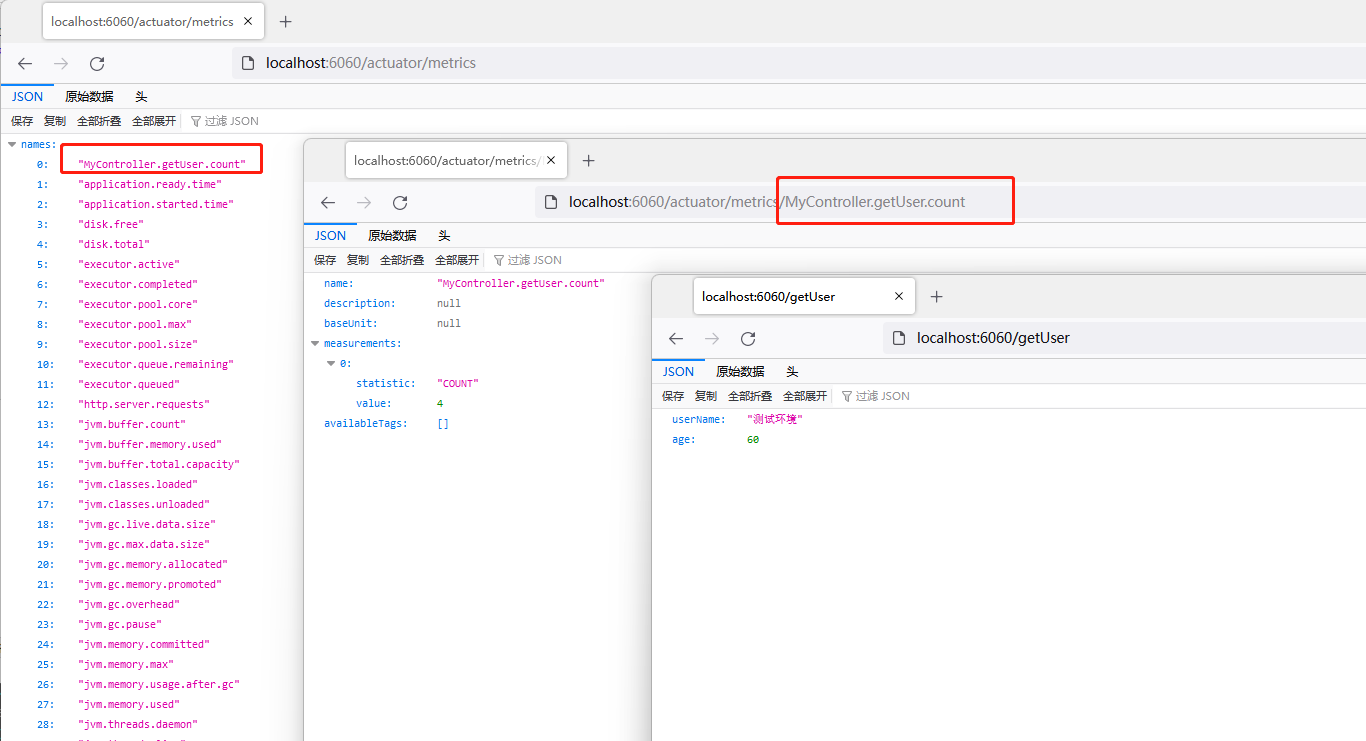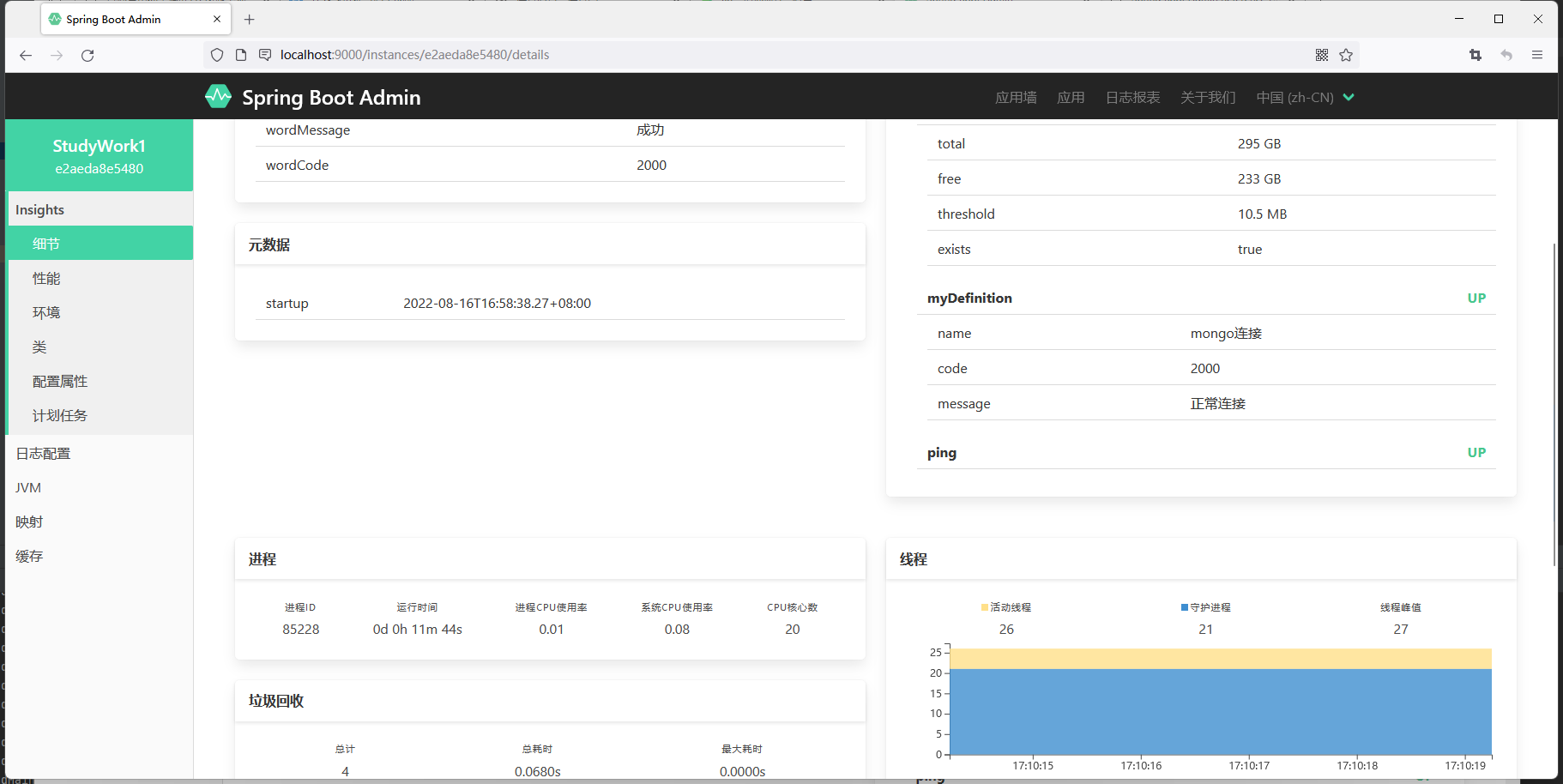监控项目指标-SpringBoot Actuator
一、初识
引入环境
<!-- 引入监控功能--> <dependency> <groupId>org.springframework.boot</groupId> <artifactId>spring-boot-starter-actuator</artifactId> </dependency>
访问监控
http://localhost:6060/actuator
访问后一下只有health一个端口,其余需要手动开启,往下看

其中 下面是获取当前项目健康状态
http://localhost:6060/actuator/health
UNKNOWN -- 未知
UP -- 正常
DOWN -- 下架
OUT_OF_SERVICE -- 终止服务

//查看业务模块是否正常运行
http://localhost:6060/actuator/health/{*path}
二、了解信息
使用的端点
|
ID |
描述 |
|
|
暴露当前应用程序的审核事件信息。需要一个 |
|
|
显示应用程序中所有Spring Bean的完整列表。 |
|
|
暴露可用的缓存。 |
|
|
显示自动配置的所有条件信息,包括匹配或不匹配的原因。 |
|
|
显示所有 |
|
|
暴露Spring的属性 |
|
|
显示已应用的所有Flyway数据库迁移。 |
|
|
显示应用程序运行状况信息。 |
|
|
显示HTTP跟踪信息(默认情况下,最近100个HTTP请求-响应)。需要一个 |
|
|
显示应用程序信息。 |
|
|
显示Spring |
|
|
显示和修改应用程序中日志的配置。 |
|
|
显示已应用的所有Liquibase数据库迁移。需要一个或多个 |
|
|
显示当前应用程序的“指标”信息。 |
|
|
显示所有 |
|
|
显示应用程序中的计划任务。 |
|
|
允许从Spring Session支持的会话存储中检索和删除用户会话。需要使用Spring Session的基于Servlet的Web应用程序。 |
|
|
使应用程序正常关闭。默认禁用。 |
|
|
显示由 |
|
|
执行线程转储。 |
如果您的应用程序是Web应用程序(Spring MVC,Spring WebFlux或Jersey),则可以使用以下附加端点:
|
ID |
描述 |
|
|
返回 |
|
|
通过HTTP暴露JMX bean(需要引入Jolokia,不适用于WebFlux)。需要引入依赖 |
|
|
返回日志文件的内容(如果已设置 |
|
|
以Prometheus服务器可以抓取的格式公开指标。需要依赖 |
配置文件配置
1).配置所有
# management 是所有actuator的配置
management:
endpoints:
enabled-by-default: true #默认开启所有端点
web:
exposure:
include: '*' # 以web方式暴漏所有端点

http://localhost:6060/actuator
http://localhost:6060/actuator/metrics
http://localhost:6060/actuator/metrics/jvm.buffer.count
......
一级一级看到指标
2).配置详细
management:
endpoint:
health:
show-details: always #显示详细信息 默认是never 不显示详细信息

3).开启单个端口
management:
endpoints:
enabled-by-default: false
web:
exposure:
include: '*'
endpoint:
health:
show-details: always #显示详细信息 默认是never 不显示详细信息
enabled: true # 健康状态开启
info:
enabled: true # 开启info
beans:
enabled: true # 开启beans
metrics:
enabled: true

三、深入
自定义Health
配置
server: port: 6060 management: endpoints: enabled-by-default: false web: exposure: include: '*' endpoint: health: show-details: always #显示详细信息 默认是never 不显示详细信息 enabled: true # 健康状态开启
@Component public class MyDefinitionHealthIndicator extends AbstractHealthIndicator { /** * title 自定义检查 * * @param builder * @throws Exception */ @Override protected void doHealthCheck(Health.Builder builder) throws Exception { // 封装其他信息集合 Map<String,Object> map = new HashMap<>(); // 测试是否正常 if( 1 == 1 ){ // 正常 //builder.up(); // 另一种写法 builder.status(Status.UP); map.put("message","正常连接"); map.put("code","2000"); }else{ // 不正常 //builder.down(); // 另一种写法 builder.status(Status.DOWN); map.put("message","死机"); map.put("code","3000"); } // 可以单个添加,也可以添加集合 builder.withDetail("name","mongo连接") .withDetails(map); } }
访问

其中名称就是类名把后面的HealthIndicator截取掉后的名字
自定义info
第一种配置
yaml
management: endpoints: enabled-by-default: false web: exposure: include: '*' endpoint: info: enabled: true # 开启info info: env: enabled: true #启用配置里的info开头的变量
info: appName: StudyWork1_yaml version: 1.0.1.0 mavenProjectName: @project.artifactId@ #使用@@可以获取maven的pom文件值 mavenProjectVersion: @project.version@
pom
<build> <plugins> <!--支持yaml读取pom的参数--> <plugin> <groupId>org.apache.maven.plugins</groupId> <artifactId>maven-resources-plugin</artifactId> <version>3.2.0</version> <configuration> <encoding>UTF-8</encoding> <delimiters> <delimiter>@</delimiter> </delimiters> <useDefaultDelimiters>false</useDefaultDelimiters> </configuration> </plugin> </plugins> </build>
访问

第二种配置
配置
management: endpoints: enabled-by-default: false web: exposure: include: '*' endpoint: info: enabled: true # 开启info
@Component public class MyInfoiInfoContributor implements InfoContributor { /** * title 自定义构建info * * @param builder */ @Override public void contribute(Info.Builder builder) { // 其他参数集合 Map<String,Object> map = new HashMap<>(); map.put("wordCode","2000"); map.put("wordMessage","成功");
// 当个存放 builder.withDetail("message","消息") .withDetail("code","状态码") .withDetails(map); } }
访问

第一种和第二种可以一起使用,结果是两种的集合,Java代码内容优先级高
自定义Metrics
配置
management: endpoints: enabled-by-default: false web: exposure: include: '*' endpoint: metrics: enabled: true
@Controller public class MyController { @Autowired private User user; Counter counter; public MyController(MeterRegistry meterRegistry){ counter = meterRegistry.counter("MyController.getUser.count"); } @ResponseBody @GetMapping("/getUser") public User getUser(){ // 计数 counter.increment(); return user; } }
访问

自定义端点Endpoint
@Component @Endpoint( id= "myService") public class MyServiceEndpoint { /** * title 端点的读操作 */ @ReadOperation public Map getOracleInfo(){ Map<String,Object> map = new HashMap<>(); map.put("name","oracle"); map.put("id","127.0.0.1"); return map; } /** * title 端点的写操作 */ @WriteOperation public void stopOracle(){ System.out.println("Oracle 停止!"); } }
访问

四、可视化adminserver
官网地址 https://github.com/codecentric/spring-boot-admin
1.新建一个项目
2.pom
<dependencies> <dependency> <groupId>org.springframework.boot</groupId> <artifactId>spring-boot-starter-web</artifactId> </dependency> <dependency> <groupId>de.codecentric</groupId> <artifactId>spring-boot-admin-starter-server</artifactId> <version>2.5.1</version> </dependency>
3.主控制类(启动类)中添加注解
@EnableAdminServer
4.properties设置端口
server.port=9000
5.启动项目
6.在需要监控的项目中配置
1).
<!-- 引入监控功能--> <dependency> <groupId>org.springframework.boot</groupId> <artifactId>spring-boot-starter-actuator</artifactId> </dependency> <!-- adminServer客户端 --> <dependency> <groupId>de.codecentric</groupId> <artifactId>spring-boot-admin-starter-client</artifactId> <version>2.5.1</version> </dependency>
2).yaml
management:
endpoints:
enabled-by-default: true #开放所有端口
web:
exposure:
include: '*' # web形式都可以访问所有端口
endpoint:
health:
show-details: always
spring:
boot:
admin:
client:
url: http://localhost:9000/ # 注册到adminServer服务
instance:
prefer-ip: true # 使用ip注册 默认是计算机名称
application:
name: StudyWork1 # 注册项目的名称 默认名称是spring-boot-application(InstanceProperties类)
7.访问控制界面
http://localhost:9000/






【推荐】国内首个AI IDE,深度理解中文开发场景,立即下载体验Trae
【推荐】编程新体验,更懂你的AI,立即体验豆包MarsCode编程助手
【推荐】抖音旗下AI助手豆包,你的智能百科全书,全免费不限次数
【推荐】轻量又高性能的 SSH 工具 IShell:AI 加持,快人一步
· DeepSeek 开源周回顾「GitHub 热点速览」
· 物流快递公司核心技术能力-地址解析分单基础技术分享
· .NET 10首个预览版发布:重大改进与新特性概览!
· AI与.NET技术实操系列(二):开始使用ML.NET
· 单线程的Redis速度为什么快?